Yamaha YZF-R125 Service Manual: Measuring the compression pressure
NOTE:
Insufficient compression pressure will result in a loss of performance.
1. Measure:
Valve clearance Out of specification →Adjust.
Refer to "ADJUSTING THE VALVE CLEARANCE" on page 3-3.
2. Start the engine, warm it up for several minutes, and then turn it off.
3. Remove:
- Rider seat
- Right upper side cowling Refer to "GENERAL CHASSIS" on page 4-1.
4. Remove:
- Fuel tank Refer to "FUEL TANK" on page 7-1.
5. Disconnect:
- Coolant temperature sensor coupler "1"
- Spark plug cap "2"
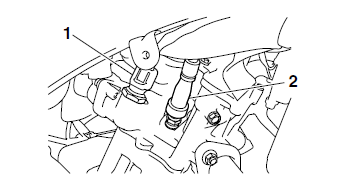
6. Remove:
- Spark plug
| CAUTION: Before removing the spark plug, use compressed air to blow away any dirt accumulated in the spark plug well to prevent it from falling into the cylinder. |
7. Install:
- Extension "1"
- Compression gauge "2"
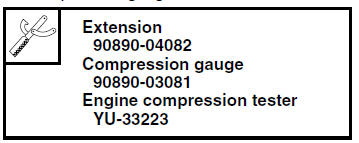
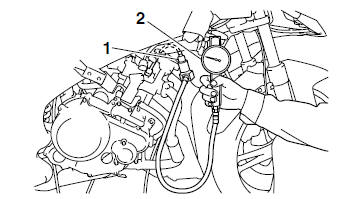
8. Measure:
- Compression pressure
Out of specification Refer to steps (c) and
(d).
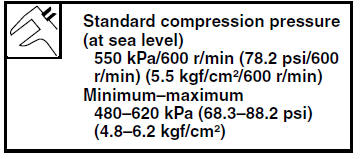
a. Set the main switch to "ON".
b. With the throttle wide open, crank the engine until the reading on the compression gauge stabilizes.
c. If the compression pressure is above the maximum specification, check the cylinder head, valve surfaces and piston crown for carbon deposits.
Carbon deposits Eliminate.
d. If the compression pressure is below the minimum specification, pour a teaspoonful of engine oil into the spark plug bore and measure again.
Refer to the following table.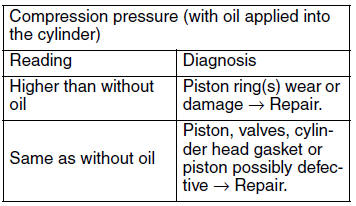
9. Remove:
- Extension
- Compression gauge
10.Install:
- Spark plug

11.Connect:
- Spark plug cap
- Coolant temperature sensor coupler
12.Install:
- Fuel tank Refer to "FUEL TANK" on page 7-1.
13.Install:
- Right upper side cowling
- Rider seat Refer to "GENERAL CHASSIS" on page 4-1.
 Checking the ignition timing
Checking the ignition timing
NOTE:
Prior to checking the ignition timing, check the
wiring connections of the entire ignition system.
Make sure all connections are tight and free of
corrosion.
1. Remove:
Rider seat
L ...
 Checking the engine oil level
Checking the engine oil level
1. Stand the vehicle on a level surface.
NOTE:
Place the vehicle on a suitable stand.
Make sure the vehicle is upright.
2. Start the engine, warm it up for several minutes,
and then turn it ...
Other materials:
Checking and charging the battery
WARNINGBatteries generate explosive hydrogen gas
and contain electrolyte which is made of poisonous
and highly caustic sulfuric acid.
Therefore, always follow these preventive
measures:
Wear protective eye gear when handling or
working near batteries.
Charge batt ...
Checking the camshaft sprocket and timing chain guide
1. Check:
Camshaft sprocket
More than 1/4 tooth wear "a" Replace
the
camshaft sprocket, timing chain and crankshaft
as a set.
a. 1/4 tooth
b. Correct
1. Timing chain roller
2. Camshaft sprocket
2. Check:
Timing chain guide (exhaust side)
Damage/wear Replace.
...
Installing the swingarm
1. Lubricate:
Bearings
Spacers
Dust covers
Pivot shaft
2. Install:
Bearings "1"
2. Swingarm
A. Left side
B. Right side
3. Install:
Swingarm adjusting collar "1"
Swingarm "2"
Pivot shaft
Pivot shaft nut "3"
a. Install, and then fully turn in the swingarm adju ...
